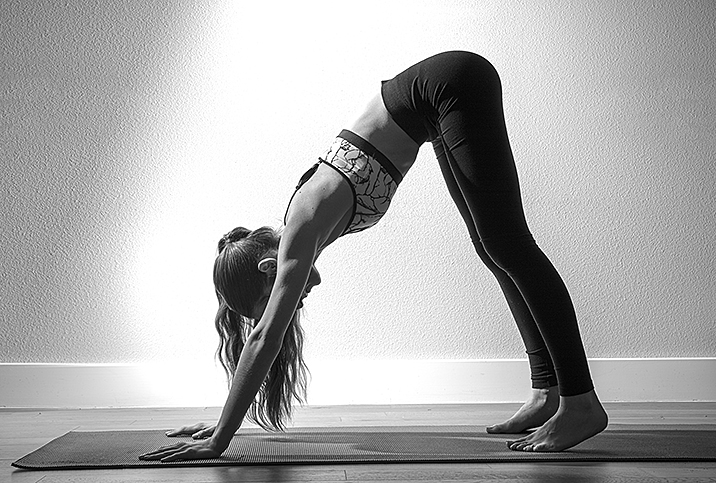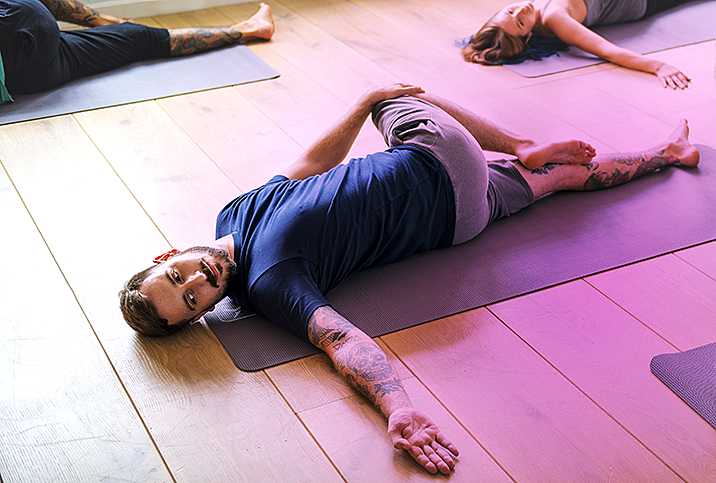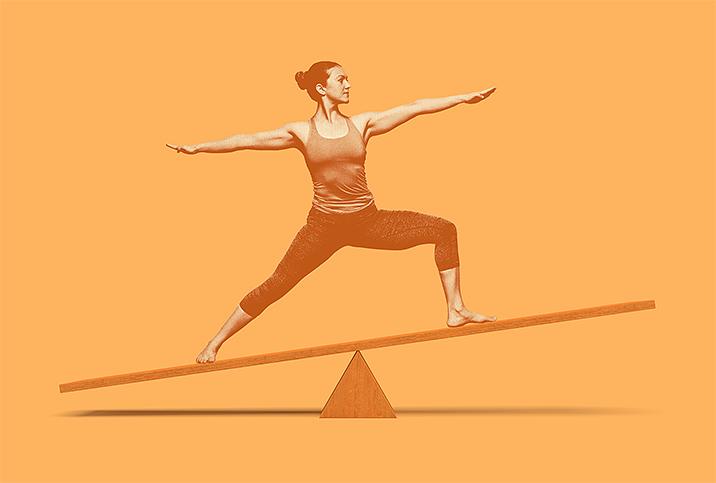Does Yoga Help Period Cramps?

Through a mix of online and in-studio classes, I've learned that the potential health benefits of yoga are nothing to scoff at. That is especially true when it comes to yoga's ability to alleviate some of the mental and physical menstrual symptoms.
The year is 2011. I am 14 years old, sitting on a yoga mat and giggling with my best friend as her mom teaches our weekly teen yoga class. She's in the process of instructing poses she says are especially helpful during our "time of the month." We've both had our periods for a couple of years, so talking about it this way seems hilarious.
More than a decade later, yoga has become one of my primary tools for coping with anxiety, staying physically strong, and easing aches and pains during my period.
Can yoga help you feel better during your period?
"Yoga can help women feel better physically, mentally and emotionally during their periods," said Anna Passalacqua, a certified yoga teacher and a co-founder of Breathing Deeply Yoga Therapy in Northampton, Massachusetts. "It can help reduce your symptoms, focus your attention away from your symptoms, improve your mental health and improve your reproductive health."
I've come to really experience major benefits, including reduced anxiety, improved overall physical health and less painful periods.
Yoga can help you feel better by allowing you to get in tune with your body and your breath, but there are some specific poses that could potentially help to ease tension in sore spots, promote healthy blood flow and regulate your cycle.
What are some yoga poses to try during your period?
Some people find several yoga poses for period cramps and general menstrual pain helpful. Pay attention to your body and switch poses if you become uncomfortable or something doesn't feel right.
Child's pose
This pose stretches your hips, thighs and lower back, helping to relieve any tension or stiffness in these areas, Passalacqua said. It's also an especially restful and restorative pose, allowing you to de-stress, relax and quiet the mind.
How to perform the child's pose: Sit on your knees, leaning forward while keeping your bum on your heels and rest your forehead on the floor.
Cobra pose
This pose helps stretch the ovarian and uterine muscles. By stimulating these muscles, you can find relief from menstrual cramps, help regulate your menstrual cycle and promote greater hormonal balance, according to Passalacqua.
How to perform the cobra pose: Do it by lying on your stomach with your toes pointing backward, and use your arms to lift the chest while keeping the elbows close to the body.
Reclining hand-to-toe pose
The reclining hand-to-big-toe pose is another great choice during your time of the month, said Melie Purdon, a yoga instructor in Jersey City, New Jersey, with YogaRenew Teacher Training. This pose stretches the legs, promotes flexibility in the hips, stretches the pelvic organs, tones the inner thighs, and relaxes and strengthens the pelvic floor.
How to perform the reclining hand-to-toe pose: Start by lying on your back. Wrap a strap around the ball of your right foot and extend the right leg to the side while holding the strap in your right hand.
Standing wide-angle pose
From the forward-fold family, this pose can help quiet the mind. The addition of a chair allows you to remain in the pose for several breaths, which, in time, can help relax the abdomen, Purdon said.
How to perform the standing wide-angle pose: Use a chair by the wall. Stand in front of the wall with your legs spread wide and the outer edges of your feet pressing down, then bend forward and rest your arms and head on the chair while keeping your back flat.
Other yoga positions worth trying to potentially help with period pain and discomfort include the following:
- Reclined easy seat
- Cat-cow pose
- Head-to-the-knee pose with a bolster and folded blanket
- Fish pose
- Standing forward fold pose
Remember to breathe through the poses and listen to your body.
"Women can also incorporate breathing exercises or meditation to lower stress, relax and shift attention away from painful or uncomfortable symptoms," Passalacqua said.
What yoga poses should I avoid during my period?
A few poses would be wise to avoid during your period because "the body's working overtime," Purdon said. Move at a slower, more restorative practice.
"No one knows your body better than you do," Purdon said, adding that you can always go into child's pose if a certain posture doesn't feel right during your class. "If it doesn't feel good or you have a doubt, skip it."
Hot yoga, or yoga practiced in a heated room or environment, is also something to steer clear of during your period, Passalacqua said. It could make you more prone to dehydration and exhaustion.
Dehydration could actually increase your menstrual cramps and discomfort, Passalacqua said.
How can I help release tension and find pain relief by using yoga?
Yoga can help reduce stress, improve your flexibility and strengthen your muscles, according to the Nationwide Children's Hospital. As someone who's practiced yoga to varying degrees throughout my life, I can't recall a time when I didn't leave a class feeling at least slightly better than when I walked in.
But it's only within the past few years, since I started practicing on a regular basis, that I've come to really experience major benefits, including reduced anxiety, improved overall physical health and less painful periods.
"The essence of its benefits lies in the principle that it must be performed with consistency throughout life, regardless of injuries, sickness or impediments," Purdon said.
And what I love so much about yoga is its focus on each individual person's body and needs. Sometimes you make it to that challenging in-person class, and other times you meet yourself where you are, focusing solely on deep breathing and stretching. That, according to Purdon, is exactly what yoga is all about.
The bottom line
In a sense, I am jealous of the 14-year-old version of myself who had so few responsibilities, challenges, and aches and pains that using yoga as therapy seemed laughable.
But I couldn't be more thankful for what developing a regular yoga practice has done for me in my adult life. Whether I'm feeling achy, anxious or even generally well, my practice is there to help enhance my well-being and improve how I feel.
What could be funny about that?


















